
LES ROUGES EAUX
VALLEY
| The campaign in the Vosges was beginning to
resemble the fighting in Italy. Rain gave way to snow, and returned to cast hardships on
the doughboy. Men of the 142nd took up the Division’s attack on November 5 as they
edged their way down the Les-Rouges-Eaux Valley, sandwiched deep in the heavily wooded
hills of the Foret Dominiale Du Champ. Progress was slow at first, visibility through the
mass of growth very limited. Craftily planted mines in the dense foliage made every step a
cautious one. Bitterly it rained again and again during the operation, and at the last a
heavy wet snow whitened the battlescene. Tired T-Patchers, without shelter, rainsoaked and
cold, fought on for days without a let-up. The enemy was forced to fall back continually
until all of the large forest that had enclosed the "Lost Battalion" was
cleared. La Houssiere and Vienville, towns at the edge of the Corcieux plain, were
captured on November 11. |
|

| Doughboys of the 142nd Infantry trudge down narrow,
snow-covered Les Rouges Eaux Valley. |

| German bazooka fire knocked out this tank destroyer in valley
battle. |
|
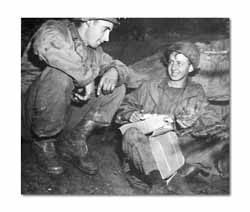
| S/Sgt. Thomas E. Bonhannon, 132nd Field Artillery, ogles a
Christmas fruit cake just received by Pvt. Placide LaBelle. |
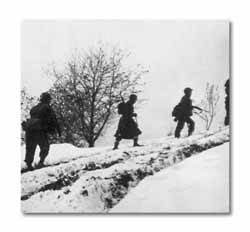
| The 3rd Battalion, 141st, moves up to new positions in snow. |
|
|
EARLY
CHRISTMAS
Back in the States generously-providing parents,
wives and sweethearts obeyed to the letter the Postmaster General’s order that
overseas Christmas boxes be mailed early. The result—yuletide came to the Vosges in
mid-autumn. To puptents in Tendon, to humble homes in Herpelmont, and, to chateaus in
Lepanges, the mail clerk in his traditional December role of Santa Claus bore premature
gifts of fruit cake, toilet articles, and woolen sweaters. Beginning the last week in
October, the Division Post Office handled many thousands of packages, averaging seven to a
man, until by Christmas Eve there was little need for Joe to hang out his water-soaked
stocking. Prancer and Blitzen had been too fast this year.
|
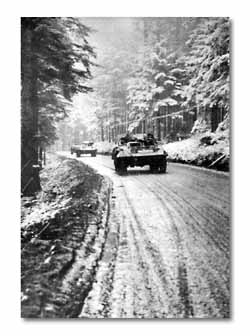
| Recon MBs move slowly through the snow-draped Vosges Forests. |
|
|

| Doughboys pack up their troubles and smile even in Vosges
snowfall. |
|
C0RCIEUX
As the Germans fell back before the 36th in the
Vosges, they carefully prepared a strong line of defense along the Meurthe River.
In this they resorted to unusual ruthlessness. Our forces first awakened to the fact when
the dark skies of night turned to a glowing red throughout the valley. Patrols confirmed
the reports of fleeing civilians coming into our lines—that Germans had set fire to
entire villages on a broad path before their Meurthe River line. Civilians were
systematically told to leave and their homes stripped of valuables before the torch was
applied. Corcieux, fair-sized village in the valley, was an example. Hundreds of French
civilians were left homeless.
|
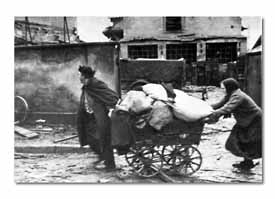 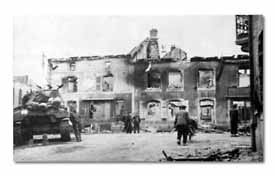 |
|